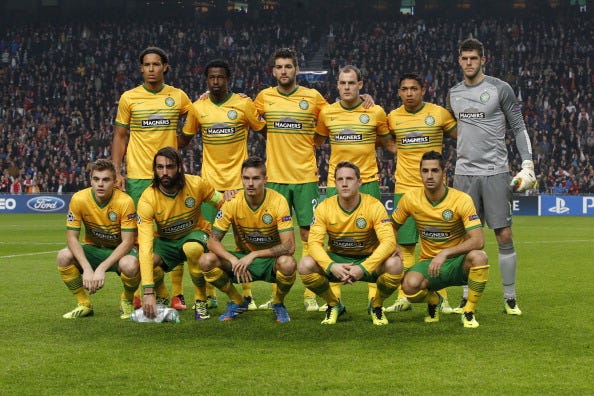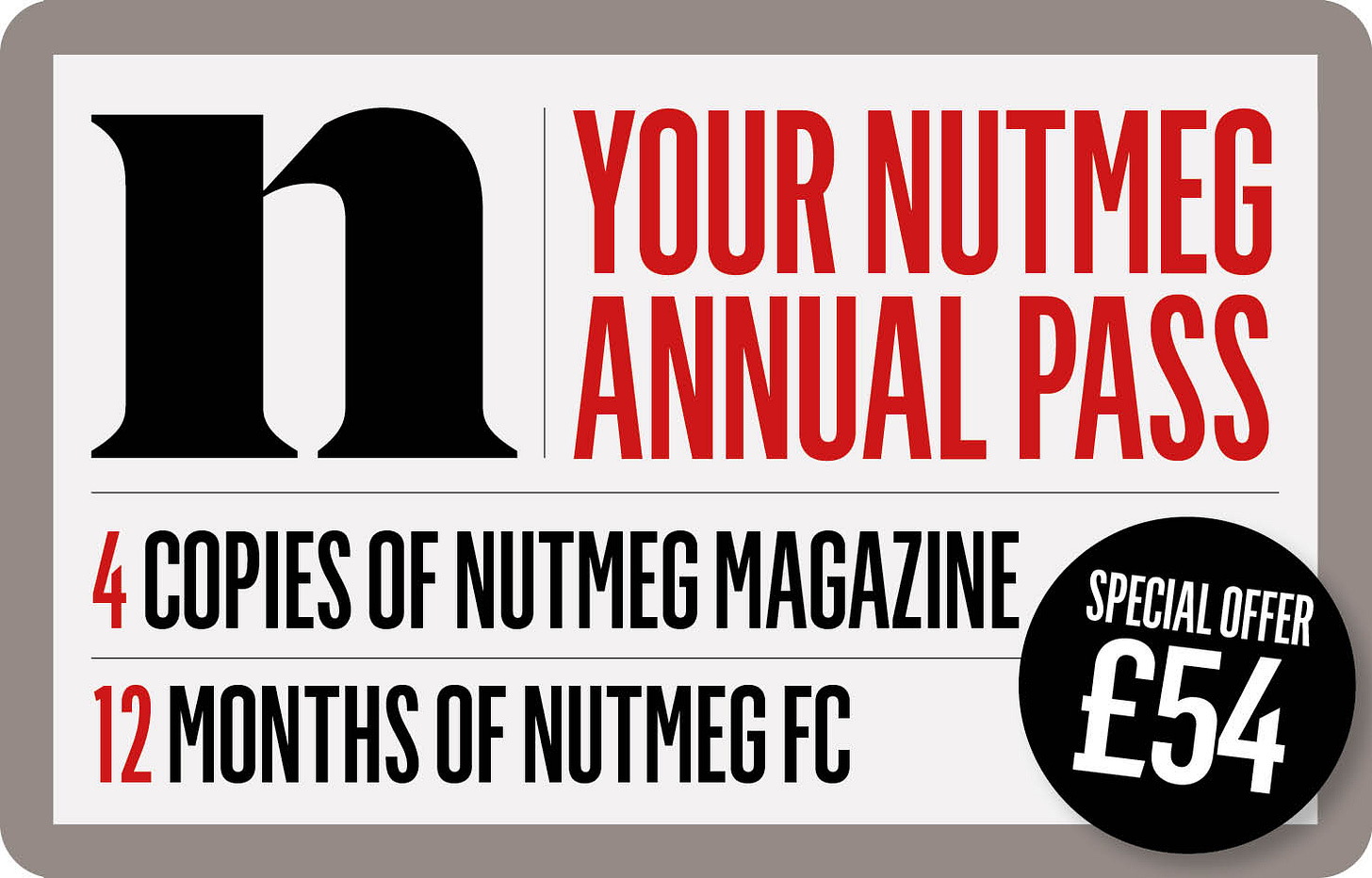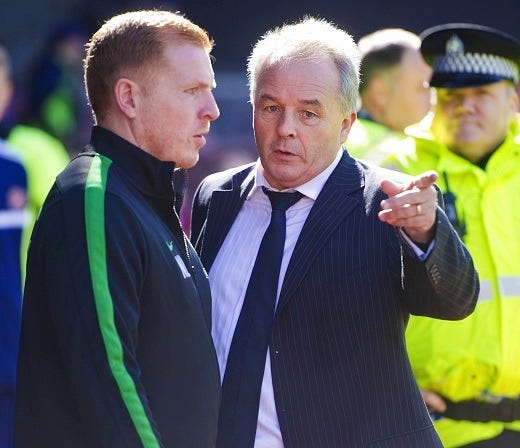Virgil van Dijk in Scotland #1: 'This guy's a Rolls-Royce.' How Celtic landed the player who would become the World’s Best Defender™
Ajax passing on Van Dijk was like Decca snubbing the Beatles
Award-winning sportswriter Stephen McGowan writes monthly investigations for Nutmeg FC. This week, he recalls Celtic’s two-year love affair with Virgil van Dijk, the centre-half who went on to reach the highest heights with Liverpool and should be considered one of the best players ever to have graced the Scottish game.
Today we consider the Parkhead club’s extraordinary capture of the 21-year-old Van Dijk from Dutch club Groningen in 2013, thanks to (unfounded!) doubts harboured by Ajax technical director Marc Overmars.
🗣️ Tomorrow: Part II — More reflections from Celtic’s former football development manager John Park and ex-teammate Charlie Mulgrew on Van Dijk’s special talent.
🗣️ Wednesday: Part III — John Hughes reveals how he achieved an unlikely Inverness Scottish Cup victory over Ronny Deila’s Celtic and star man Virgil.
This article is free, but parts II and III, like most of our content, are paid. Don’t miss out… get a Nutmeg season ticket. Sign up and get 12 months of access PLUS a year’s subscription to the beautiful, 200-page print quarterly — delivered straight to your door.
By Stephen McGowan
In the summer of 2013, Dutch giants Ajax were in the market for a central defender. Sifting through the options, Marc Overmars, the club’s technical director, faced a straight choice between two promising players.
Two years at Groningen had prepared Virgil van Dijk for the next step in his career. Brighton had shown interest, Krasnodar of Russia also. At the age of 21, Van Dijk held off in the hope of one of the big three clubs from the Netherlands making their move.
The doubts had always been there. In 2008 Van Dijk was a short, slow right-back with an unstable knee at Willem II. At the age of 17, he shot up seven inches in height. Even then Edwin Hermans, coach of the club ’s reserve team, thought he had “too many limitations”.
A scout for Groningen, Martin Koeman, the Dutch international father of Ronald and Erwin, saw something more. Cycling to games because he couldn’t yet drive, Van Dijk made his debut for the northern club on May 28, 2011, and scored twice. Despite a bout of potentially fatal peritonitis and kidney poisoning before his 20th birthday, bigger clubs sat up and paid attention.
Ajax swithered after a poor performance for Holland’s under-21 team against Italy. A Utrecht player had also caught the eye of Overmars and, like Decca turning down the Beatles, the Amsterdam club decided to go with Mike van der Hoorn instead of Van Dijk.
For Celtic, that decision opened the window of opportunity. Central defenders Thomas Rogne and Rami Gershon had already left Parkhead. Nigeria international Efe Ambrose was scheduled to miss the start of the season due to the Confederations Cup. Kelvin Wilson, meanwhile, craved a return to England.
“I spoke to guys at Ajax and they were hanging about because they weren’t sure about Virgil’s pace,” says Celtic’s former football development manager John Park. “They took so long to move it opened a door for us to do something.
“At that point, we were sourcing all the best players in our bracket. You compile a list and work your way through them. You do your research. Eventually you identify players you like and start going out to games and having a look.
“I had a number of players in the system. And, of all of them, I believed that Van Dijk could fit our jigsaw.”
Now working for St Mirren, Park was the talent-spotter who dug up the likes of Scott Brown, Kevin Thomson, Steven Whittaker and Garry O’Connor for Hibernian. Moving to Celtic, he implemented the player-trading model which uncovered Victor Wanyama, Moussa Dembele, Mikael Lustig, Adam Matthews, Emilio Izaguirre and Beram Kayal.
None of them would match the career of Van Dijk, now 34 and the captain of Liverpool and the Netherlands. Despite the current travails of Arne Slot’s side, he remains the most recognisable and, arguably, the best defender on the planet.
During two seasons in Glasgow, the Dutchman played 113 times for Celtic, winning two league titles and a League Cup. He cost just £2.2million and left for six times as much.
“We had been to a few Groningen games and watched a lot of video,” Park reveals. “But you need the buy-in from the people round about you as well. You need the nuts and bolts behind the scenes to come together. We were doing technical work with our analysts at the time and our video scouts kept checking information.
“We needed the buy-in from upstairs that we were in the ballpark, money-wise. A whole team of people were doing work on it. And eventually we started to think, ‘This is interesting’.
“The management team of Neil Lennon, Johan Mjallby and Garry Parker kept watching him behind the scenes. And we could see his football arrogance. He was a player who clearly believed in himself.
“But the hardest part of all these things is the final decision. At some point you have to say, ‘Right, let’s push the button’. And we got that one right.”
While supporters of Celtic and Rangers bicker over the respective talents of Henrik Larsson, Brian Laudrup and Paul Gascoigne, Van Dijk is often overlooked on the list of the best overseas footballers to have played in Scotland. Remarkably for a central defender, he could score goals almost as spectacular as Larsson or Laudrup. A young player learning how to be a winner in a demanding environment, he illuminated the Glasgow goldfish bowl for two years.
“When we eventually did sign him, I remember Neil coming up the stairs after watching him,” Park recalls. “He was like a kid in a sweet shop and I remember him saying to me, ‘John, this guy’s a Rolls-Royce.’”
Remember that description. We’ll return to it later.
Lennon, now manager of Dunfermline, recalls his early excitement after catching his first look at his new six-foot four-inch central defender with “legs like tree trunks”.
“John Park and his team flagged Virgil up,” he told Open Goal this summer. “Then we watched videos of him and you’re like, ‘Fucking hell, he’s like Rio Ferdinand’.
“Johan Mjallby (Lennon’s former assistant) watched him and you know what Johan is like. He’ll say, ‘He’s good, but he should do this better and he should do that better’.
“I don’t know how the club did it. We got him for £2.2m and as soon as he walked in the building, you’re like, ‘He’s phenomenal, absolutely phenomenal’.
“Handsome fella. Legs like two tree trunks. Just made well.”
There were times in Scottish football when he resembled the Primary Seven kid running rings around the infant school pupils in the playground. He strolled forward with the ball, effortlessly won headers, brushed opponents aside with his physicality. Ultimately the move served its purpose as a stepping stone towards the billionaires’ playground of the English Premier League.
“The Premier League was the big dream since I was at the academy of Willem II,” Van Dijk told journalist Graham Hunter. “It was always the dream to go to the Premier League and when I went to Celtic the dream came closer.
“The step to Celtic from Holland was such a good one, such a big one for me. Living abroad, talking English — or Scottish — every day. I understand a bit of Scottish now and it was testing in the beginning!”
Former Celtic defender Charlie Mulgrew remembers his new teammate making an instant impression during a pre-season work-out. Even then, he seemed too good to be true. A footballer so flawless he could have been a product of AI.
“I always use the analogy that if you were creating your own player on the FIFA video management game Virgil would be the guy who was 99 out of 100 on nearly everything,” Mulgrew tells Nutmeg FC.
“One of his first sessions, certainly his first game, was a closed-door game against Crewe at the training ground. He strode forward with the ball as if the other team weren’t there and cracked a shot off the underside of the crossbar and you’re thinking, ‘Oooft…’
“Every attribute he had was world class. His speed made him the fastest player, his height and strength made him the best in the air, he read the game superbly. Technically he could hit long diagonal passes or smash a free-kick. He just had it all.
“I would need to put Virgil up there as the top player I’ve played with.”

Scottish football is different. Physicality is imperative, everything happens at speed. At times it feels as if hard work, perspiration and the ability to lob a throw-in 30 yards is valued more highly than technical craft or invention.
Van Dijk made a confident debut for Celtic in a 2-0 win over Aberdeen at Pittodrie. Straight after the game, players and staff drove straight to Dyce Airport to catch a chartered private jet to Kazakhstan for a Champions League play-off. A former Soviet outpost closer to Asia than Aboyne, a time difference of six hours posed logistical difficulties from the start. In an act of supreme self-sacrifice, Scottish journalists — this one included — embraced advice to remain on UK time by occupying the hotel bar until 6am.
The pre-match headlines concerned Shakhter Karagandy’s practice of sacrificing sheep for luck. Yet the blood spilled on the artificial surface of the Astana Stadium was human, Van Dijk starting in bruising 2-0 defeat for his new club. In Glasgow the judgements are quick and early impressions were indifferent.
“He struggled in that game,” recalls Mulgrew. “They were very physical and launching long throws into the box. It was a difficult place to play.
“The second leg was at Parkhead and Neil Lennon put Mikael Lustig in at centre-back instead of Van Dijk. He was dropped. We won 3-0 and I think he learned from that the importance of the physical side of the game. That was a learning curve.”
If Van Dijk expected life in Scotland to be easy, Shakhter Karagandy provided a timely and useful wake-up call.
“I got so many bad reactions from so many fans,” he remembers. “They were right, I was poor that night, so then it was about how you’re going to bounce back.
“I remember the return game at Celtic Park because it was the final game before you’re either going to be in the Champions League or not. I was on the bench.
“We went 1-0 up, 2-0 up and then three. So basically we were through then and in the last couple of minutes I came on and we all celebrated. We were going to play Champions League and that was one of the main reasons I went to Celtic.
“It was a very challenging couple of weeks at that time, but after three or four games I had the flow and kept playing and progressing. I felt so good and the quality of my game kept getting better as well.”




